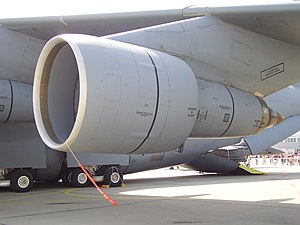TF39
| TF39 | |
|---|---|
 |
|
| A TF39 on a C-5 Galaxy at ILA (Internationale LuftfahrtAusstellung) in Berlin, 2008 | |
| Type | Turbofan |
| Manufacturer | GE Aviation |
| First run | 1964 |
| Major applications | Lockheed C-5 Galaxy |
| Variants | General Electric CF6 |
| Developed into | General Electric LM2500 |
The General Electric TF39 is a high-bypass turbofan engine. Developed to power the Lockheed C-5 Galaxy, it was the first high-power, high-bypass jet engine available. The TF39 was developed into the CF6 series of engines, and formed the basis of the General Electric LM2500 marine and industrial gas turbine.
The United States Air Force opened the "CX-X Program" in 1964, intending to produce a next-generation strategic airlifter. Of the several airframe and engine proposals returned for consideration, Lockheed's aircraft and General Electric's engine were selected for the new design in 1965.
The high-bypass turbofan was a huge leap in engine performance, offering a thrust of 43,000 pounds, while improving fuel efficiency by about 25%. The TF39 had an 8-to-1 bypass ratio, a 25-to-1 compressor pressure ratio, and a 2,500 °F (1,370 °C) turbine temperature made possible by advanced forced-air cooling. The first engine went for testing in 1965. Between 1968 and 1971, 463 TF39-1 and -1A engines were produced and delivered to power the C-5A fleet.
The TF39 was a revolutionary 1960s engine rated from 41,000 to 43,000 lbf (191 to 205 kN) of thrust. It incorporated new features for a turbofan engine such as:
These features, together with advances in core technology described below, contributed to a significant improvement in fuel efficiency over any engines available at the time.
The engine also included features developed from previous GE engines:
Today, a conventional turbofan featuring a T-staged fan would have an overhung fan rotor (without any inlet guide vanes), followed by one or more T-stages supercharging the core stream alone. The name T-staged fan is derived from the overall appearance of the LP compressor when the side elevation is shown diagrammatically.
GE took a different approach with their first high bypass ratio turbofan, the TF39. A unique, very complex design; the T-stage, which supercharges the core stream, is located ahead of the main fan rotor. The T-stage itself comprises an overhung mini-rotor followed by a set of outlet guide vanes; the main fan rotor is located immediately behind these OGV's. Outboard of the T-stage rotor are the main inlet guide vanes, which only affect the bypass stream. The T-stage rotor extends to about half the main rotor stage annulus and runs in a tip shroud. The main fan stage has a mid-span platform/flow splitter which separates the single-stage outer annulus from the 2-stage inner annulus. These two stages mainly supercharge the 16-stage high-pressure compressor. However, a fair proportion of the air entering the T-stage is bled off into the bypass duct, there being two annular passages leading to the bypass duct. The nominal bypass ratio of 8:1 must refer to the ratio of total bypass mass flow to HP compressor entry mass flow.
...
Wikipedia
